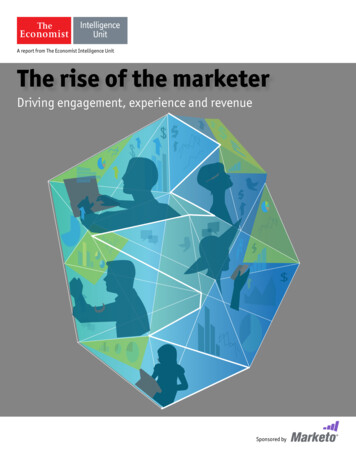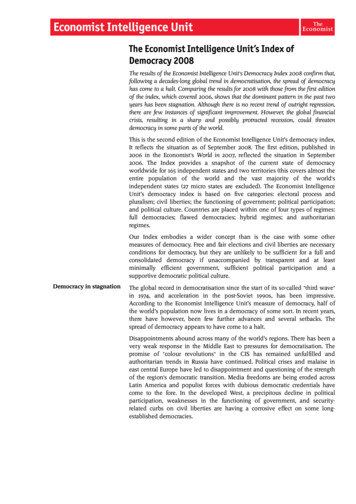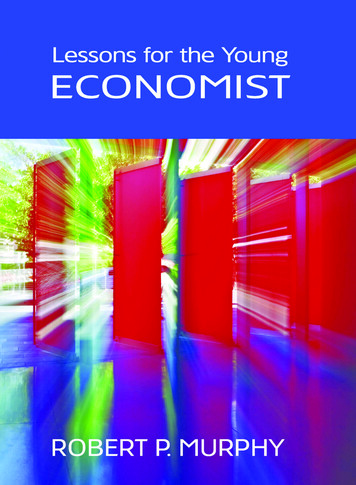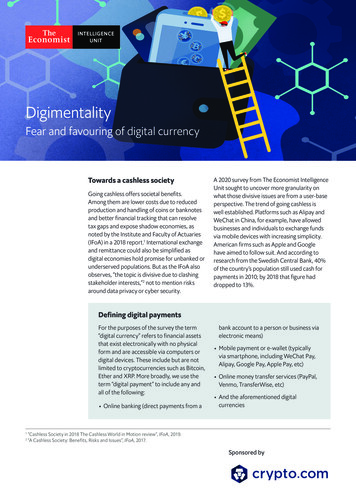
Transcription
A report from The Economist Intelligence UnitThe rise of the marketerDriving engagement, experience and revenueSponsored by
The rise of the marketer Driving engagement, experience and revenueContents1About this report2Executive summary3Introduction51How marketers see the future72Marketing as a revenue driver103Experience leading to engagement124The skills hunt155The marketing technology ecosystem17Conclusion19Appendix: Survey results20 The Economist Intelligence Unit Limited 2015
The rise of the marketer Driving engagement, experience and revenueAbout thisreportThe rise of the marketer: Driving engagement,experience and revenue is an Economist IntelligenceUnit report, sponsored by Marketo. The EconomistIntelligence Unit bears sole responsibility for thecontent of this report. The findings do notnecessarily reflect the views of the sponsor.The report draws on two main sources for itsresearch and findings:l A survey that included responses from 478 CMOsand senior marketing executives worldwide.More than 50% of respondents hold the CMOtitle or top marketing position. Respondents arelocated in North America (33%), Europe (30%),Asia-Pacific (29%) and Rest of World—whichencompasses Africa and Latin America (9%).More than 50% of survey respondents (52%)hail from companies with more than US 500min revenue; 20% have revenue of over US 5bn.l A series of in-depth interviews with seniorexecutives.2 The Economist Intelligence Unit Limited 2015IntervieweesJohn Dragoon, Executive Vice-president and ChiefMarketing Officer, Houghton Mifflin HarcourtChris Clark, Group Head of Marketing, HSBCMayur Gupta, Global Head, Marketing Technology& Innovation, Kimberly-ClarkRaja Rajamannar, Chief Marketing Officer,MasterCardLuanne Calvert, Chief Marketing Officer, VirginAmericaJamie Moldafsky, Chief Marketing Officer, WellsFargoBrian Harrington, Executive Vice-president andChief Marketing Officer, ZipcarWe would like to thank all interviewees and surveyrespondents for their time and insights. The reportwas written by Dan Armstrong and edited byGilda Stahl.
The rise of the marketer Driving engagement, experience and revenueExecutivesummaryMore than 80% ofmarketingexecutivessurveyed say theyneed torestructuremarketing tobetter support thebusiness—29%believe the needfor change isurgent.3Marketers have seen their jobs transformed overthe past ten years. The transformation ishappening again—but faster this time. Accordingto the Economist Intelligence Unit’s survey of 478high-level marketing executives worldwide, morethan 80% say they need to restructure marketingto better support the business. And 29% believethe need for change is urgent.Marketers believe that change will occur in sixareas:1. Marketing will increasingly be seen less as acost and more as a source of revenue. Theproportion of companies where marketing isviewed as a cost centre will dwindle and thenumber where it is seen as a driver of revenuewill grow. In three to five years, surveyrespondents say, approximately four of fivecompanies will classify the marketing functionas a revenue driver. (Whether marketing has aformal P&L is another matter.)2. Marketing will take the lead in the customerexperience. The customer experience isincreasingly seen as a key to competitiveadvantage in every industry. Slightly more thanone-third of marketers polled say they areresponsible for managing the customerexperience today. However, over the next threeto five years, 75% of marketers say they will beresponsible for the end-to-end experience overthe customer’s lifetime. The Economist Intelligence Unit Limited 20153. Engagement is becoming paramount. Amarketer’s greatest achievement is an engagedcustomer. And because an engaged customerkeeps coming back, engagement is defined mostoften in terms of sales and repeat sales. Morethan six out of ten (63%) marketers polled saythat engagement is manifested in customerrenewals, retention and repeat purchases.Adding in the 15% who see engagement interms of impact on revenue, a full 78% ofmarketers see it as occurring in the middle orlater stages of the classic funnel.1 A minority(22%) view engagement in terms of love for abrand—still important, but part of marketing’slegacy skill set.4. The new marketer combines operational anddata skills with a grasp of the big picture (andpossibly working within a differentorganisational structure as well). Marketersare aggressively seeking new skills—especiallythose who believe that change is urgent. Nearlyfour of ten marketers (39%) want new blood inthe two areas of digital engagement andmarketing operations and technology. A closethird, and not significantly different, is skills inthe area of strategy and planning (38%).Meanwhile, marketers are tinkering withorganisational structures to foster agility,1The marketing, purchase or conversion funnel refers to the customer’sjourney from awareness (when the customer first learns about a product orservice) to interest, desire and purchase. Often a fifth stage, advocacy, isadded.
The rise of the marketer Driving engagement, experience and revenueincrease cross-functional co-operation and helpthe organisation to scale.5. Digital and data dominate investment.Technology investment plans by marketersillustrate both the dominance andfragmentation of digital channels. Three of thefour most widely cited investments are aimed atreaching customers through different channels:via social networks, on mobile devices and onthe old standby of e-mail. The fourth, analytics,is needed to knit together data from multiplechannels into a coherent and actionable portraitof the consumer.6. Two trends to watch: real-time personalisedmobile and the Internet of Things. Just overhalf of marketers expect the Internet of Things—where ubiquitous, embedded devices withunique IP addresses constantly convey real-timedata—to revolutionise marketing by 2020.Almost the same proportion cites the power ofreal-time personalised mobile communicationsas the trend with the biggest impact.4 The Economist Intelligence Unit Limited 2015
The rise of the marketer Driving engagement, experience and revenueIntroductionIf you think marketing has changed in the past fiveyears, just wait and see what’s to come—or, moreto the point, act. When a tidal wave appears on thehorizon, you can wait to be swallowed, find highground or run to get your surfboard. Over the lastten years, CMOs have had a lot of practice copingwith tidal waves. Those who have adapted nowhave their surfboards well within reach.Chief marketing officers are surviving in theirjobs longer than in the past—45 months as of ayear ago, almost double the tenure in 2006.2 Butthe average large-company CMO still lasts onlyabout half as long as a chief executive. Everymarketer can tell a painful story about the reasonswhy: higher expectations from business owners,greater complexity, the need for entirely new skillsets, the need for new partners and a higher levelof accountability. The business owners must delivernumbers. The CMO who can’t help is soon gone.“It’s very intense right now,” says RajaRajamannar, CMO of MasterCard. “Marketing hasbecome a significant item on the P&L, so it is beingchallenged like never before. It’s a greatopportunity.”Marketers know they need to change to bettersupport the business. They see the rise ofdisruptive competitors and new technologies. Allaround them are the bodies of counterparts whofailed to adapt. And while they can’t see the precise25Suzanne Vranica, “Average CMO Tenure: 45 Months (But That’s anImprovement),” Wall Street Journal, March 23, 2014, http://on.wsj.com/17dfskp The Economist Intelligence Unit Limited 2015shape that the future will take, they know it won’tlook like the present.“Marketing, sales, service, communications andother customer-oriented functions are evolvingand commingling, and we don’t know what they’regoing to look like in five years,” says JamieMoldafsky, CMO at Wells Fargo. “The traditionalsales function isn’t going away. But I think theways people come to us and enter a relationshipwon’t look anything like it does now.”According to our research, marketers see fourtrends:1. A broader view of customer experience. Apositive customer experience across alltouchpoints is increasingly seen as a company’smost valuable asset. And, more than any otherfunction, marketing is responsible for managingit—across the customer life cycle and acrosschannels, from initial awareness through loyaltyand advocacy.2. Metrics for revenue and engagement.Effectiveness trumps efficiency, especially in atime of rapid change. Metrics will becomebroader and more comprehensive, focusing ontop-line revenue and overall engagement morethan efficiency and brand awareness.3. The talent hunt. Yes, there is a need fortech-savvy marketers. But it’s not enough byitself. CMOs want people with the ability to grasp
The rise of the marketer Driving engagement, experience and revenueand manage the details (in data, technology andmarketing operations) combined with a view ofthe strategic big picture. Creative is stillimportant (especially in B2C), but it is a legacyskill and no longer a focus of demand.4. The ecosystem in the future. Marketingtechnology is proliferating through the cloud tothe point where almost all companies—even thesmallest ones—use multiple systems operatingwithin an overall marketing operating system.Despite expectations of consolidation around afew dominant enterprise suppliers, marketersbelieve that the number of systems in theircompanies will grow.6 The Economist Intelligence Unit Limited 2015
The rise of the marketer Driving engagement, experience and revenue1How marketers see the futureA large majority of marketers—more than fourfifths of survey respondents—believe that now isthe time to embark on rapid change in the way theyrun the marketing function. They agree with MayurGupta, global head of marketing technology andinnovation at Kimberly-Clark, when he says, “Youcan look at future disruption as a multiple of whathappened in the past. Disruption in the last fiveyears might show you what will happen in the nextthree. Disruption accelerates exponentially.”We asked marketers whether they agreed withthe statement that they need to change theirapproach over the next three to five years to bettersupport the business. The answers were scored on ascale from one to ten, with one signifying “disagreestrongly” (no need to change anything aboutmarketing) and ten “agree strongly” (an urgentneed to change the approach to marketing). Theresults show a strong vote in favour of dramaticand urgent change.l More than four out of five (81%) agree with thestatement: “We need to change the structureand design of our marketing organisation tomeet the needs of our business over the nextthree to five years.”l The sentiment cuts across all groups: B2B andB2C, large companies and small ones, CMOs andlower-level executives.l At almost 90%, Europeans are most inclined toagree; at 72%, North Americans are leastinclined to agree.Organisation of marketingAgree or disagree: We need to change the structure and design of our marketing organisation to meet the needs of ourbusiness over the next 3-5 years.(% 3456789AgreecompletelySource: Economist Intelligence Unit survey, November 2014.7 The Economist Intelligence Unit Limited 2015
The rise of the marketer Driving engagement, experience and revenueAgree or disagree: We need to change the structure and design of our marketing organisation to meet the needsof our business over the next 3-5 years.(% respondents)6050403020100Don’t need to changeNeed to changeUrgently need to rce: Economist Intelligence Unit survey, November 2014.Three views on the need to changeWe simplified the responses to this question bydividing them into three categories: those whobelieve there’s little need to change, those whobelieve change is needed but there’s little urgencyand those with a burning desire for change.l The smallest group of marketers—19%, or aboutone in five—sees no need to change. They tendto believe that the way they’re operating now isthe way they will need to operate in the future.It could be that they’re complacent becausethey’ve mastered the new technology ofmarketing. But because that technology ischanging all the time, and even the mostsophisticated marketers have a hard timekeeping up, it is more likely that they simplyaccept a legacy role.l The largest group of marketers—just over half,or 52%—agrees on the need to change, butdoesn’t feel strongly about it. These marketerscould be called “the evolutionaries”: they favourincremental change at a measured pace.8 The Economist Intelligence Unit Limited 2015l A third group of marketers—29%—stronglybelieves that marketing must change itsapproach to better support the business. Theygive the statement a nine (11%) or ten out often (18%). They are change agents—“corporaterevolutionaries”. Perhaps marketing in theirorganisations is seen as a purely creativefunction and these respondents want to keep upwith their more technology- and data-savvycompetitors. Perhaps they have already madebig strides in this area and are thirsty tocapitalise on the momentum. Whatever theirsituation, they see vast potential that is notbeing realised—and they want to move quicklyto capture it.What makes the revolutionaries different? Thesurvey reveals that, in greater numbers than theirmore conservative counterparts, they are morelikely to be seen as a cost centre and aspire to driverevenue, to be accountable for managing theend-to-end customer experience and engagement,to move aggressively to acquire talent and toactively leverage data and technology.
The rise of the marketer Driving engagement, experience and revenueHow to evolve a marketing function: the culture of small betsIn the movie Groundhog Day, as Bill Murray livesthe same day over and over, the small experimentshe tries ultimately enable him to chart a courseto success and happiness. It’s not just theexperiments that succeed that are valuable;those that fail turn out to be just as necessary andworthwhile.That’s one of the lessons cited by BrianHarrington, EVP and CMO of the US-based carsharing service Zipcar, in his efforts to foster acompany-wide philosophy of “small bets”, ie,rapid-fire piloting of small marketing programmesthat can be scaled up, tweaked or shut downdepending on the outcomes. The programmesspan everything from the types of marketingpartnerships pursued to the acquisition channelsused to the member engagement programmesoffered.“I encourage folks to take risks day to day andmonth to month,” says Mr Harrington. “We talk alot about what small bets mean to the organisationand how to carry them out. That means that wecelebrate failure as well as success—and that’s OK.”Shared processes ensure that the corporateoffice and the field use the same methodology toevaluate outcomes and share results. “We definesuccess metrics for the particular programme andtest whether it met them. We also evaluate whetherit has the ability to scale, because we’re rapidlybecoming a large business with a global footprint,so we need to be thinking about small bets thatcan turn into scalable opportunities,” says MrHarrington.And it’s not just Zipcar. “You can’t ask thecustomers what they want,” says Chris Clark, grouphead of marketing at HSBC, “because they don’tknow. You know the story about Henry Ford saying,‘If I asked people what they wanted they’d have9 The Economist Intelligence Unit Limited 2015said a faster horse.’ I’m with Steve [Jobs] andHenry on that one. When we ask our customerswhat they want, they say a lower rate on their loan.But beyond that, we just need to come up withideas based on what we know about our customersor can imagine about what might make their liveseasier and see what works. And if I’m rigorousabout measuring the experiments, I know exactlywhat doesn’t work and what does and needs to beexpanded.”The need to accept potential failure as the priceof success sounds obvious and to many marketersit is. Google runs more than 1,000 experiments amonth, and only about 10% lead to changes in thebusiness—thus 100 business improvements carrya price of 900 failed experiments. Dan McKinleyat the online crafts marketplace Etsy wrote that“nearly everything fails” and “it’s been humblingto realise how rare it is for [features] to succeed onthe first attempt”. 1But that’s not the way many marketers think. Ina widely publicised survey conducted two years agoby the Corporate Executive Board, 21% of Fortune1,000 marketers don’t agree with the statement,“My team accepts that some experiments must failin order for us to learn from them.”2 Even in smallscale experiments, failure is still toxic in manyorganisations.A single experiment has only a small effect. Butthe results of many small bets shared across anorganisation can, bit by bit, create a road map thatleads to big changes in the future.1Ron Kohavi, Alex Deng, Brian Frasca, Toby Walker, Ya Xu and NilsPohlmann, “Online Controlled Experiments at Large Scale,” lledExperimentsAtLargeScale.aspx2Corporate Executive Board Marketing Leadership ng-communications/marketing/index.page
The rise of the marketer Driving engagement, experience and revenue2Marketing as a revenue driverManagement guru Peter Drucker once said that thejob of marketing was to make sales obsolete. Theconventional wisdom is that this is starting tohappen: Marketers are going deeper into thefunnel, into what used to be the territory of sales.They are taking on e-commerce responsibilities andeven getting their own P&Ls. But many marketersdon’t see the cost-revenue split in such stark andbinary terms, although they do see theiraccountability for revenue growing.When marketers are asked how they are viewedby the business owners, they say that they areviewed both as revenue drivers (69% agree, 19%strongly) and cost centres (68% agree, 26%strongly). At most companies, the business ownersknow that marketing drives revenue, but the viewthat marketing is a cost is just as widespread(especially in Europe).In three to five years, however, the view ofmarketing will change. It will less frequently (downby 3%) be seen as a cost centre and more often as adriver of revenue. The marketing function is slowlymigrating from the cost side of the ledger to therevenue side.Perception of marketing as a cost centreMarketing is viewed as a cost centre now.-32% DisagreeAgree 68%Marketing will be a viewed as a cost centre in 3-5 years.-35% Disagree-40-30Agree 65%-20-10010203040506070Source: Economist Intelligence Unit survey, November 2014.Perception of marketing as a revenue driverThe business owners treat marketing as a revenue driver today.-31% DisagreeAgree 69%The business owners will treat marketing as a revenue driver in the next 3-5 years.-21% Disagree-30-20-10Agree 79%01020304050607080Source: Economist Intelligence Unit survey, November 2014.10 The Economist Intelligence Unit Limited 2015
The rise of the marketer Driving engagement, experience and revenueHow marketers expect views to change in the next 3-5 years(% respondents)Perception of marketingas a cost centre -3%-3-2-1Perception of marketingas a revenue driver 10%012345678910Source: Economist Intelligence Unit survey, November 2014. If you don’t acceptaccountability forbeing measured interms of yourcontributions andoutputs, then youare viewed as acost centre. John Dragoon,EVP and CMO, HoughtonMifflin Harcourt11How will that change take place? A lot has to dowith how marketing presents itself within theorganisation. Says John Dragoon, CMO of HoughtonMifflin Harcourt (HMH): “You reap what you sow. Ifyou don’t accept accountability for being measuredin terms of your contributions and outputs, thenyou are viewed as a cost centre. If you aggressivelypursue an agenda of accountability andtransparency, then you’ll be viewed as a trustedpartner and adviser. Even if you don’t have a formalP&L, you’re seen as a revenue owner.”Moreover, revenue owners tend to have differentreporting arrangements. When marketing reportsto finance or sales, it is often viewed as a costcentre or at the very least as an unequal partner.“In my case, I report to the CEO, which says a lotabout how our CEO and HMH as a whole viewmarketing,” says Mr Dragoon.Importantly, revenue owners are able to showhow they drive revenue—perhaps not at the pointwhere the transaction occurs, but they can showinfluence. Even public relations (PR) activities canbe shown to have a revenue impact. “We did acampaign where we used social media and PR tohelp Virgin America secure two gates at Love Field[a Dallas airport],” says Luanne Calvert, CMO ofairline Virgin America. “We were able to get ourguests to sign a petition on Change.org andpersuade local officials in Dallas to give their okayto us getting two gates at Love Field that ourcompetitor did not want us to have.” Possessinggates at older urban airports, close to downtownWashington, DC, like Reagan or New York’sLaGuardia airports, can have a significant effect onrevenue. In this case, marketing had a big indirectimpact.A more obvious example of driving revenue islead generation: following the classic funnel andreligiously tracking opportunities as they move The Economist Intelligence Unit Limited 2015from unqualified to marketing-qualified to salesqualified to a close. “About a quarter of ourdemand initiates through marketing outreach andmarketing activities,” says Mr Dragoon. “We do twothings: identify demand ourselves, make sure it’sproperly qualified, goes into the right channel;and, for demand that has already been identified,we help our salesforce accelerate cycle times andwin rates.”But even lead generation is getting morecomplex. “In the past, marketing brought theconsumer to the brand, and the sales team inspiredthe consumer to make the purchase,” saysKimberly-Clark’s Mr Gupta. “But now the CMO hasto drive an experience that can win that consumerat any point of the funnel, because there really isno funnel anymore. The consumer is at the centre.Marketing has to be able to inspire the consumer’sbehaviour everywhere in the consumer’s world.”Who gets credit for revenue? Ultimately,marketers are part of a team, and claiming creditfor revenue often isn’t the best way to buildteamwork. “It [the cost versus revenue divide] isnot a useful distinction,” says HSBC’s Chris Clark.“Seeing any part of the organisation in that binaryway is an old-fashioned mindset. We play a teamsport. You can’t win a football game with an entireteam of running backs.”Adds Mr Dragoon: “We need to recognise that amultitude of touchpoints and activities ultimatelyresult in a customer acquiring your products. I’mless interested in having marketing teams takepersonal credit for what they do and moreinterested in creating an environment where weachieve the top line together. When there’s a win,we do a look-back over the previous 12 months tofind correlations with events they attended, e-mailsthey opened and samples they downloaded. That’snot the same as claiming credit.”
The rise of the marketer Driving engagement, experience and revenue3 There is more of aneed for thearticulation of anintegrated,holistic approachthan before,because there aremyriad channelsand contactpoints. Jamie Moldafsky,CMO, Wells FargoExperience leading to engagementCustomer experience—the sum of experiences acustomer has over the life of the relationship—isincreasingly seen as a key to competitiveadvantage. By delivering a personal, memorableexperience, companies can create a distinctoffering that engages customers and createsadvocacy and loyalty. Because almost everyone in acompany has a role in some touchpoint—fromfinancing terms to inventory management topackaging, support and random person-to-personinteractions—there has been little oversight of thetotal customer experience.That is changing. Slightly more than one-thirdof marketers polled say they are responsible formanaging the customer experience today.However, over the next three to five years, 75% ofmarketers say they will be responsible for theend-to-end experience over the customer’slifetime. Moreover, as responsibility for thecustomer experience shifts to marketing, it ismoving away from customer support and sales. Thedistinction between sales and marketing—in whichsales owns relationships and marketing ownsmessaging—has become less distinct. Asconsumers gain power and become less reliant onsales, the marketing function is increasinglyorchestrating relationships.As recently as five years ago, centralisingmanagement of the customer experience was lessnecessary. Says Wells Fargo’s Ms Moldafsky: “Thereis more of a need for the articulation of anintegrated, holistic approach than before, simplybecause there are myriad channels and contactpoints.”Also driving the need for oversight of thecustomer experience is the need to turn complexservices into offerings that customers find easy tounderstand and use. “Businesses like ours require across-channel, cross-product, cross-businessperspective,” says Ms Moldafsky. “Somebody has toWho is responsible for customer experience now? In 3-5 years?NowIn 3 years(% respondents)MarketingSalesCustomer supportProduct managementFinance0510152025303540455055Source: Economist Intelligence Unit survey, November 2014.12 The Economist Intelligence Unit Limited 2015
The rise of the marketer Driving engagement, experience and revenueExpected change over the next 3-5 years in responsibility for customer experience(% respondents)MarketingProduct managementFinanceCustomer supportSales-15-12-9-6-303691215Source: Economist Intelligence Unit survey, November 2014.integrate across channels and across businessesfrom the customer’s point of view. Somebody hasto shape and articulate truly customer-centricstrategies.”It’s an idea that brings to mind the originalMacintosh computer, which pioneered an intuitiveinterface in a command-line world. Internalcomplexity translated into external simplicity, atheme highlighted by Zipcar’s EVP and CMO, BrianHarrington: “If you look at what we do from theoutside, it looks simple. Cars by the hour, gas andinsurance included. But on the inside, it’scomplicated. Try maintaining 10,000-plus carsparked in lots of different places around the worldand giving members access on a 24/7 basis.Self-service is tough to do and we do it very well.”But if almost everyone in the company has a rolein customer experience, how can marketing gainthe kind of control needed to oversee the myriadinteractions that drive engagement? In the EIU’sConversations with six marketing visionaries, SethGodin argued that control is illusory and influencemore important: “Nobody’s in charge of everyone,even the CEO. Influence is way more importantthan authority. Marketers gain influence asthey give up more credit and take on moreresponsibility.”Echoing that point is Houghton Mifflin Harcourtor HMH’s Mr Dragoon, who argues that “the notionof a single point of accountability may beintellectually appealing. But customer experienceis too important to be left to just the marketers,because it involves how you develop, market, sell,service and support products across the whole life13 The Economist Intelligence Unit Limited 2015cycle.”Mr Dragoon sees marketing’s role as one ofadvocacy on behalf of the customer rather thandirect control. “Even if marketing doesn’t have soleaccountability, it is first among equals in makingsure everyone understands their role in creatingtouchpoints that are differentiated, consistent andoutstanding. Customer experience is a matrix withmarketing taking a central role, even if it’s not thelead role.”And since no one can manage everything, thefirst step is identifying the key drivers ofengagement and setting priorities around thosedrivers. “In some places you need to be consistent.In others, guidelines or independent actions areOK,” says Ms Moldafsky of Wells Fargo. “We’re acomplex company, with lots of different points ofcontact and interfaces for customers, so we try toanswer the question, ‘What capabilities do we needto support consistency in key experiences acrossthe organisation?’ And then we prioritise, integrateand make sure we have the right guidelines andguideposts around the customer experience.”From experience to engagement. The reasonmarketers strive to create those differentiated,consistent and outstanding touchpoints is to buildengagement. And engagement, which used to beseen as more about branding and awareness, isincreasingly perceived as key to the loyalty andadvocacy stages of the customer life cycle. Anengaged customer is one who sticks around.More than six of ten (63%) marketers polledagree that engagement is best reflected in customer
The rise of the marketer Driving engagement, experience and revenueWhich definition best captures what “engagement” means to you?(% respondents)Customer renewals/Repeat purchases/RetentionBrand awarenessImpact on revenueOther100203040506070Source: Economist Intelligence Unit survey, November 2014. It’s hard toattribute revenueat the top of thefunnel. As you getinto considerationand purchase andloyalty andadvocacy, it’seasier to see howengagementresults in revenue. Luanne Calvert,CMO, Virgin Americarenewals, retention and repeat purchases. Addingin the 15% who define engagement in terms ofimpact on revenue, a full 78% of marketers see it asoccurring in the middle or later stages of the classicfunnel. And the 22% of marketers who do viewengagement as heightened brand awareness aresignificantly less likely to think that marketingneeds to change—or, at best, they have little senseof urgency around the need for change. These arethe “traditionalists”, who see their main job ascreating an engaging brand story. It’s a role thatremains imp
2 The Economist Intelligence Unit Limited 2015 The rise of the marketer Driving engagement experience and revenue About this report The rise of the marketer: Driving engagement, experience and revenue is an Economist










